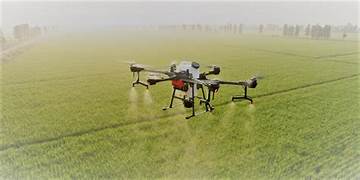Featured in The hindu businessline
It’s Biggest Revolution In The Country’s Agriculture Since The Green Revolution
New seeds are being sown across India. Farmers who once looked to the skies, cradled a fistful of soil and applied traditional wisdom to get the most out of their harvests are now migrating to a new set of tools. They are leveraging the power of robots, drones, soil sensors, smart cameras, and Artificial intelligence (AI), among a wide array of tech-based solutions.
It’s the biggest revolution in Indian agriculture since the Green Revolution, and it’s only just the beginning. Using a farmer-first approach, the Agri-tech Revolution – the use of emerging technologies in agriculture to maximise its potential – is promising to radically transform the farm-to-fork journey. Sweeping across the entire agricultural value chain, it is improving productivity, enhancing efficiency, creating sustainable farming solutions, generating a host of post-harvest opportunities and significantly increasing incomes. It’s what Indian farmers once only dreamt of.
Sense of urgency
There is a sense of urgency being generated by these agile, new-age agricultural technologies, and it is easy to see why:
India is one of the world’s largest food producers in the world and it holds the record for the second-largest amount of cultivable land
Agriculture is the principal means of livelihood of more than 55 per cent of the total workforce and 70 per cent of rural households
This sector accounts for only 18.3 per cent of India’s GDP
Traditionally, agriculture in India has been a low-tech industry marked by numerous challenges. For decades, Indian farmers have been struggling with rising input costs, diminishing yields, massive post-harvest losses, inadequate market access and the crippling effects of middlemen on prices. Add to these challenges, the typically small size of farm holdings in India (more than 80 per cent of farmers are small and marginal) and, now, a new set of risks such as climate change, pandemics and supply chain disruptions, and the scenario looks pretty dismal.
Leveraging digital solutions
The great news is that farmers who are turning to emerging technologies are already seeing results. Not only is the excitement contagious but the forecast is excellent.
“Cool” was never something you would associate with the kisan (farmer). Now ‘app’, ‘Agribot’ and ‘cognitive computing’ are buzzwords among a growing number of Indian farmers. For instance, never before has a farmer diagnosed crop disease or pest infestation by uploading images clicked by drones hovering over their fields. These high-resolution images are sent via an app to agricultural scientists, who then present a diagnosis and offer solutions.
Precision farming is also wowing the Indian farmer. Sensors embedded in the soil transmit information via satellite to the farmer’s laptop or smartphone, about pH levels, temperature, moisture, pests and soil nutrients. And drones are selectively spraying pesticides only where needed. Solutions are therefore tailor-made, making farming efficient and saving input costs.
Powerful tool
Predictive analysis via apps can help farmers create crop calendars and solicit advice on how to manage these crops. And AI-based weather forecasting, a powerful tool in the current climate of unpredictability, is becoming a farmer’s best friend.
Agtech is also helping farmers eliminate a particularly stubborn pest – opportunistic money-lenders and other middlemen, who have been exploiting them for decades. Now banks, NBFC’s and institutions that provide agricultural finance and loans are using apps to better understand their clients’ needs and offer targeted products.
One of the greatest innovations of the Agtech revolution is the electronic-mandi (e-mandi), a virtual platform that links farmers, traders and buyers, who can trade in produce online. This helps farmers get better price discovery and, more significantly, it eliminates the ubiquitous middleman. In addition, it streamlines the process, saving considerable time and money. Online platforms also offer warehousing facilities and logistics, which greatly reduce post-harvest wastages and losses, while greatly improving supply-chain efficiencies in a frictionless and transparent manner.
Quantifying Agtech’s potential
Given the low-tech nature of agriculture in India, the opportunities agtech can create for the tiller are limitless. According to McKinsey & Company, digital technologies are putting the farmer right at the heart of the entire ecosystem and have the potential to turn India into an agricultural powerhouse. Between 2013 and 2020, the number of agritech start-ups grew from 50 to more than 1,000, encouraged by greater farmer awareness, deeper internet penetration in rural India, and the need for greater efficiency in the agriculture sector.
McKinsey & Company is hugely optimistic about the future of agritech in India. According to their forecast, “fully nurtured, the agtech ecosystem has the potential to propel Indian farmers’ incomes to grow by 25 to 35 per cent.”
The integration of technology into agriculture has brought another, unwitting, advantage – it is presenting farming as an exciting and profitable career option for a young, tech-savvy generation. In this way, agtech is playing a pivotal role in safeguarding a sustainable future for the industry.





Leave A Comment